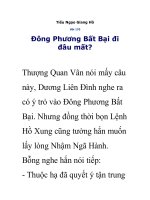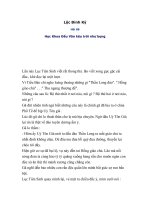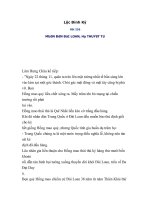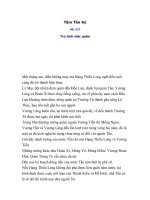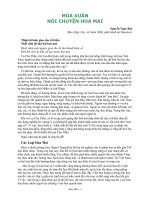Ch9.Ppt
Bạn đang xem bản rút gọn của tài liệu. Xem và tải ngay bản đầy đủ của tài liệu tại đây (2.39 MB, 59 trang )
Chapter 9 – MSI Logic Circuits
Chapter 9 Objectives
• Selected areas covered in this chapter:
– Analyzing/using decoders & encoders in circuits.
– Advantages and disadvantages of LEDs and LCDs.
– Observation/analysis techniques to troubleshoot
digital circuits.
– Operation of multiplexers and demultiplexers
in circuit applications.
– Comparing two binary numbers by using the
magnitude comparator circuit.
– Function and operation of code converters.
– Precautions when connecting digital circuits using
the data bus concept.
– Using HDL to implement MSI logic circuits equivalents.
Digital Systems: Principles and Applications, 11/e
Ronald J. Tocci, Neal S. Widmer, Gregory L. Moss
Copyright © 2011, 2007, 2004, 2001, 1998 by Pearson Education, Inc.
Upper Saddle River, New Jersey 07458 • All rights reserved
Chapter 9
• Digital systems obtain data and information
continuously operated on in some manner:
– Decoding/encoding.
– Multiplexing/demultiplexing,.
– Comparison; Code conversion; Data busing.
• These and other operations have been facilitated
by the availability of numerous ICs in the MSI
(medium-scale-integration) category.
Digital Systems: Principles and Applications, 11/e
Ronald J. Tocci, Neal S. Widmer, Gregory L. Moss
Copyright © 2011, 2007, 2004, 2001, 1998 by Pearson Education, Inc.
Upper Saddle River, New Jersey 07458 • All rights reserved
9-1 Decoders
• Decoders are used when an output or a group of
outputs is to be activated only on the occurrence
of a specific combination of input levels.
– Often provided by outputs of a counter or a register.
Digital Systems: Principles and Applications, 11/e
Ronald J. Tocci, Neal S. Widmer, Gregory L. Moss
Copyright © 2011, 2007, 2004, 2001, 1998 by Pearson Education, Inc.
Upper Saddle River, New Jersey 07458 • All rights reserved
9-1 Decoders
• A decoder accepts a set of inputs that represents
a binary number—activating only the output that
corresponds to the input number.
For each of these
input combinations,
only one of the M
outputs will be active
(HIGH); all the other
outputs are LOW.
Many decoders are designed to produce active-LOW outputs,
where only the selected output is LOW while all others are HIGH.
Digital Systems: Principles and Applications, 11/e
Ronald J. Tocci, Neal S. Widmer, Gregory L. Moss
Copyright © 2011, 2007, 2004, 2001, 1998 by Pearson Education, Inc.
Upper Saddle River, New Jersey 07458 • All rights reserved
9-1 Decoders
Circuitry for a decoder with three inputs and 8 outputs.
It uses all AND gates, so
outputs are active-HIGH
Output O6 goes HIGH only
when CBA 1102 = 610.
Digital Systems: Principles and Applications, 11/e
Ronald J. Tocci, Neal S. Widmer, Gregory L. Moss
Copyright © 2011, 2007, 2004, 2001, 1998 by Pearson Education, Inc.
Upper Saddle River, New Jersey 07458 • All rights reserved
9-1 Decoders
Circuitry for a decoder with three inputs and 8 outputs.
This can be called a 3-line-to-8line decoder—it has three input
lines and eight output lines.
Also called a binary-to-octal
decoder or converter—taking
three-bit binary input code
and activating one of eight
(octal) outputs.
Also referred to as a 1-of-8
decoder—only 1 of the 8
outputs is activated at one time.
Digital Systems: Principles and Applications, 11/e
Ronald J. Tocci, Neal S. Widmer, Gregory L. Moss
Copyright © 2011, 2007, 2004, 2001, 1998 by Pearson Education, Inc.
Upper Saddle River, New Jersey 07458 • All rights reserved
9-1 Decoders
• Some decoders have one or more enable inputs
used to control the operation of the decoder.
– The decoder is enabled only if ENABLE is HIGH.
• With common ENABLE line connected to a fourth
input of each gate:
– If ENABLE is HIGH, the decoder functions normally.
• A, B, C input will determine which output is HIGH.
– If ENABLE is LOW, all outputs will be forced LOW.
• Regardless of the levels at the A, B, C inputs.
Digital Systems: Principles and Applications, 11/e
Ronald J. Tocci, Neal S. Widmer, Gregory L. Moss
Copyright © 2011, 2007, 2004, 2001, 1998 by Pearson Education, Inc.
Upper Saddle River, New Jersey 07458 • All rights reserved
9-1 Decoders
The 74ALS138 decoder.
ENABLE
inputs
Digital Systems: Principles and Applications, 11/e
Ronald J. Tocci, Neal S. Widmer, Gregory L. Moss
Copyright © 2011, 2007, 2004, 2001, 1998 by Pearson Education, Inc.
Upper Saddle River, New Jersey 07458 • All rights reserved
9-1 Decoders
7442
BCD-to-decimal
decoder.
This decoder
does not have
an enable input.
Digital Systems: Principles and Applications, 11/e
Ronald J. Tocci, Neal S. Widmer, Gregory L. Moss
Copyright © 2011, 2007, 2004, 2001, 1998 by Pearson Education, Inc.
Upper Saddle River, New Jersey 07458 • All rights reserved
9-1 Decoders
7445 BCD-to-decimal decoder/driver.
Suitable for directly
driving loads such
as indicator LEDs
or lamps, relays,
or dc motors.
Termed a driver because this IC
has open-collector outputs that
operate at higher current/voltage
limits than a normal TTL output.
Digital Systems: Principles and Applications, 11/e
Ronald J. Tocci, Neal S. Widmer, Gregory L. Moss
Copyright © 2011, 2007, 2004, 2001, 1998 by Pearson Education, Inc.
Upper Saddle River, New Jersey 07458 • All rights reserved
9-2 BCD-to-7 Segment Decoder/Drivers
• The 7-segment display is a common way to
display decimal or hexadecimal characters.
– One common arrangement uses light emitting diodes
(LEDs) for each segment.
Diodes allow current to flow in one direction,
but block flow in the other direction.
When the LED anode is more positive than the
cathode by approximately 2 V, the LED will light up.
Digital Systems: Principles and Applications, 11/e
Ronald J. Tocci, Neal S. Widmer, Gregory L. Moss
Copyright © 2011, 2007, 2004, 2001, 1998 by Pearson Education, Inc.
Upper Saddle River, New Jersey 07458 • All rights reserved
9-2 BCD-to-7 Segment Decoder/Drivers
• The 7-segment display is a common way to
display decimal or hexadecimal characters.
– One common arrangement uses light emitting diodes
(LEDs) for each segment.
By controlling current through each LED,
some segments are turned on & emit
light, while others are turned off, which
generates the desired character pattern.
Digital Systems: Principles and Applications, 11/e
Ronald J. Tocci, Neal S. Widmer, Gregory L. Moss
Copyright © 2011, 2007, 2004, 2001, 1998 by Pearson Education, Inc.
Upper Saddle River, New Jersey 07458 • All rights reserved
9-2 BCD-to-7 Segment Decoder/Drivers
BCD-to-7-segment decoder/driver.
The 7446/47
activates specific
segment patterns
in response to
input codes
Digital Systems: Principles and Applications, 11/e
Ronald J. Tocci, Neal S. Widmer, Gregory L. Moss
Copyright © 2011, 2007, 2004, 2001, 1998 by Pearson Education, Inc.
Upper Saddle River, New Jersey 07458 • All rights reserved
9-2 BCD-to-7 Segment Decoder/Drivers
BCD-to-7-segment decoder/driver.
This is a commonanode LED display.
The anodes all of
segments are tied
together to VCC .
Another type uses a common-cathode method, with
each segment requiring 10 to 20 mA of current.
TTL/CMOS devices are normally not used to drive a commoncathode display directly—a transistor interface circuit is often used
Digital Systems: Principles and Applications, 11/e
Ronald J. Tocci, Neal S. Widmer, Gregory L. Moss
Copyright © 2011, 2007, 2004, 2001, 1998 by Pearson Education, Inc.
Upper Saddle River, New Jersey 07458 • All rights reserved
9-3 Liquid Crystal Displays
• A liquid-crystal display (LCD) controls reflection
of available light.
– The light may be ambient (room, sun) light.
• Reflective LCDs use ambient light.
– Available light might be provided by a small light
source—part of the display unit.
• Backlit LCDs use this method.
• LCDs have gained wide acceptance due to their
very low power consumption—compared to LEDs.
– LEDs have the advantage of a much brighter display
that is easily visible in dark or poorly lit areas.
Digital Systems: Principles and Applications, 11/e
Ronald J. Tocci, Neal S. Widmer, Gregory L. Moss
Copyright © 2011, 2007, 2004, 2001, 1998 by Pearson Education, Inc.
Upper Saddle River, New Jersey 07458 • All rights reserved
9-3 Liquid Crystal Displays
Liquid-crystal display.
Basic
arrangement.
Applying voltage between the
segment and the backplane turns
the segment ON.
Zero voltage turns the segment OFF.
Digital Systems: Principles and Applications, 11/e
Ronald J. Tocci, Neal S. Widmer, Gregory L. Moss
Copyright © 2011, 2007, 2004, 2001, 1998 by Pearson Education, Inc.
Upper Saddle River, New Jersey 07458 • All rights reserved
9-3 Liquid Crystal Displays
Driving a 7segment display.
It is common to produce
required ac voltage by
applying out-of-phase
square waves to the
segment and the
backplane.
Digital Systems: Principles and Applications, 11/e
Ronald J. Tocci, Neal S. Widmer, Gregory L. Moss
Copyright © 2011, 2007, 2004, 2001, 1998 by Pearson Education, Inc.
Upper Saddle River, New Jersey 07458 • All rights reserved
9-3 Liquid Crystal Displays
• Liquid crystals are available as multidigit 7segment decimal numeric displays.
– Alphanumeric LCD modules are available in
many formats—up to 4 lines by 40 characters.
• Other LCD modules allow the user to create a
graphical display by controlling individual dots on
the screen called pixels.
• Larger LCD panels can be scanned at a high rate,
producing high quality video motion pictures.
– Control lines are arranged in rows & columns.
• A digital system must activate a matrix row/column
to control the amount of light at each pixel.
Digital Systems: Principles and Applications, 11/e
Ronald J. Tocci, Neal S. Widmer, Gregory L. Moss
Copyright © 2011, 2007, 2004, 2001, 1998 by Pearson Education, Inc.
Upper Saddle River, New Jersey 07458 • All rights reserved




